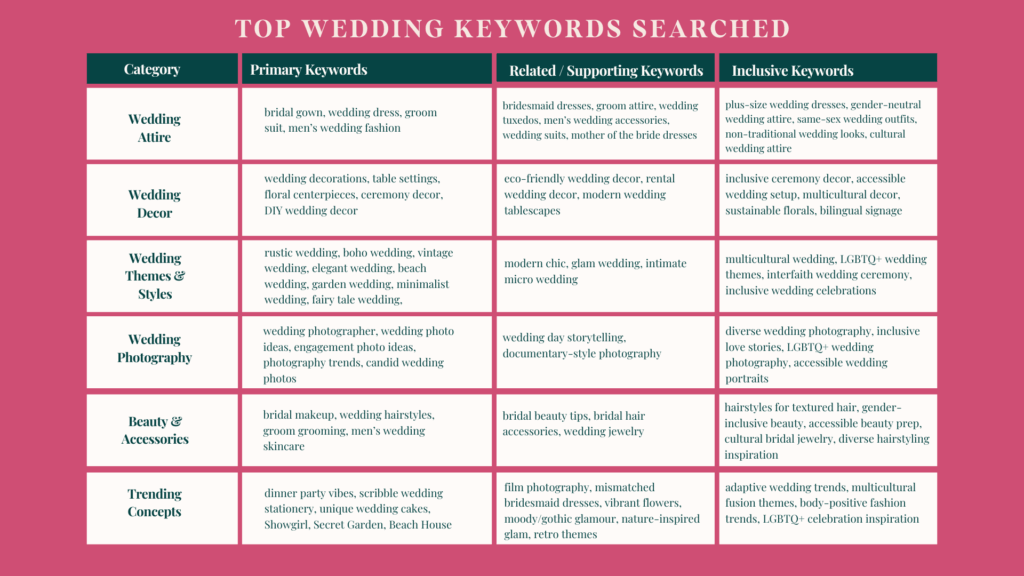Pinterest Strategy That Converts for Wedding Pros

TL;DR: Pinterest is not social media. It is a search engine with a 3-6 month delay. For wedding pros, success comes from:
- Pinning content 3-6 months before couples start searching
- Building a keyword-rich content calendar that follows the wedding planning cycle
- Using systems and batching so you stay consistent without the overwhelm
For more background on why this platform is such a powerful tool in our industry, check out my full guide on Pinterest for Wedding Pros.
Why Does Timing Matter So Much on Pinterest?
Pinterest is not Instagram. It’s not about posting in real time or chasing likes. Pinterest is a visual search engine, which means results take time to build authority.
When a couple searches for “spring wedding ideas” in March, Pinterest isn’t showing them pins created last week. It’s showing pins that have been gaining traction for months. This is why posting spring content in January positions you to be found when it matters most.
Think of it like planting a garden. You don’t plant tomatoes the day you want to eat them. You plant them months in advance so they’re ready when you need them. Same principle here.
Want a deeper dive on how to build long-term results? Read Pinterest Business Best Practices.
Why the Wedding Industry Has a Unique Advantage
The wedding industry is a Pinterest goldmine because couples use the platform for inspiration throughout the entire planning process. Even better, the industry follows a predictable cycle:
- Engagement Season: November through February
- Peak Planning: January through May
- Wedding Season: May through October
- Vendor Booking: 6-18 months before the wedding
This predictability is your superpower when paired with a seasonal pinning strategy. According to The Knot, most couples spend 12 to 18 months planning their wedding, giving you a clear 18-month window to capture their attention at every planning stage. Even better, Pinterest reports that 85% of weekly Pinners have purchased something based on pins they see from brands, making it one of the highest-intent platforms for wedding vendor discovery. See The Knot Wedding Industry Statistics for more.
I explain how this connects to year-round marketing in Pinterest Strategy for Wedding Pros to Stay Booked All Year.
Before we go further, grab the free Pinterest Keyword Tracker so you can organize your research as you learn. It takes 30 seconds to download and will make implementing everything below much easier.
The Three-Phase Approach That Actually Works
One of my wedding planner clients implemented this three-phase approach and went from 300 monthly Pinterest visitors to 4,200 in just 7 months. More importantly, she tracked 12 consultation requests directly from Pinterest traffic during that period. Here’s the exact system she used:

Phase 1: Build Your Foundation with Keywords
Success starts with keyword research. The best keywords aren’t always “wedding planning” or “wedding ideas.” They’re the late-night searches that planning couples make when they’re feeling overwhelmed.
Examples include:
- “Wedding planning checklist for busy couples”
- “Small wedding ideas under budget”
- “Wedding day timeline for photographers”
- “What to do 90 days before wedding”
Use Pinterest Trends and Ahrefs Long-tail Keywords to discover what couples are really typing into search.
You can also explore my Pinterest workflow for wedding clients to see how keyword planning fits into your systems.
Phase 2: Build Your Content Calendar
Once you have your keywords, map them into a calendar that matches the wedding cycle.
- Planning Months: timelines, checklists, vendor guides
- Inspiration Months: seasonal color palettes, styled shoots, trends
- Engagement Season: early planning guides, just-engaged checklists
- Wedding Season: behind the scenes, day-of advice, real weddings
Pinterest rewards consistency. Plan monthly themes and batch your pins in advance. For step-by-step advice, check out Buffer’s Seasonal Marketing Guide.
Feeling overwhelmed by the planning? I’ve done the heavy lifting for you. Download my Pinterest PowerPlay guide with ready-to-use seasonal content themes and 200+ wedding industry keywords.
Phase 3: Create Pins that Convert
A high-converting pin includes:
- A headline that solves a specific problem
- A design that’s easy to scan on mobile
- Keywords in the image and description
- A clear description with a call to action
Example: “Feeling overwhelmed planning your wedding? This complete checklist breaks down every step so you can stay stress-free. Perfect for busy couples who want to stay organized.”
For design tips, Canva are excellent resources.
How to Plan Your Seasonal Content

This platform is built on planning ahead. Success comes from pinning content three to six months before couples start searching. That timing gives your pins the chance to gain authority, build engagement, and rank higher in the algorithm.
For wedding professionals, this is especially powerful because couples follow a predictable planning cycle. By creating seasonal content in advance, you position your business to be discovered right when couples are actively looking for inspiration, checklists, and vendor guidance. A smart seasonal approach does more than increase impressions. It drives qualified traffic that converts into inquiries and bookings for your wedding business.
Here’s how to map out your seasonal approach:
Q1: Target Summer Wedding Season
January through March: Focus on summer and peak wedding season. Couples are searching for outdoor venues, heat-friendly décor, floral inspiration, and summer wedding looks. Create pins around “June wedding timeline,” “summer wedding color palettes,” and “outdoor wedding tips.”
Q2: Shift to Fall Content
April through June: Shift into fall content. This is when couples start hunting for rich colors, cozy textures, and seasonal planning advice. Think “fall wedding timeline,” “autumn décor ideas,” “October wedding inspiration,” and “fall bouquets.”
Q3: Prepare for Engagement Season
July through September: This is prime preparation for engagement season. Couples who are about to get engaged or newly engaged will be looking for early planning guides. Create content like “just engaged checklist,” “how to choose a wedding venue,” and “holiday proposal ideas.”
Q4: Capture Newly Engaged Couples
October through December: Engagement season is here. Target couples in the early stages of planning. Pins like “wedding planning checklist for newly engaged,” “how to set your budget,” and “first steps after engagement” will perform best. You can also begin seeding spring inspiration content to be ready for peak planning season in January.
This platform rewards consistency across all four quarters. By planning six months out, you always stay ahead of the curve. For deeper seasonal insights, I break down trends in Pinterest Strategy for Wedding Pros to Stay Booked All Year.
Take 10 minutes right now to map out your next quarter using this approach. Which season are you targeting in your next 30 days of pins? Write it down before continuing.
Which Analytics Actually Grow Your Wedding Business?
Analytics can feel overwhelming, especially when you’re not sure which numbers will actually help you grow your business. Many wedding pros get caught up in vanity metrics that look good at first glance but don’t lead to more inquiries or bookings. The key is focusing on the data that shows whether this platform is driving traffic, building your email list, and bringing couples closer to working with you.
Here are the metrics that actually grow your business:
Traffic Metrics That Indicate Real Growth
Website Traffic: Use Google Analytics or Pinterest Analytics to measure how much traffic is coming to your site. Look for increases over time, not just one or two high-performing pins.
Conversion Metrics That Show ROI
Email Signups: The goal isn’t just clicks but conversions. Track how many visitors subscribe to your freebie, download your guide, or join your list. A freebie like my Pinterest Keyword Tracker is the perfect bridge.
Consultation Inquiries: At the end of the day, inquiries are the metric that matters most. Ask new leads how they found you and track whether this platform is part of their journey.
Visibility Metrics That Build Authority
Keyword Rankings: Use Pinterest Analytics or third-party tools to see if you’re showing up for searches like “summer wedding ideas” or “wedding day timeline.” Improved rankings mean your SEO work is paying off.
Pinterest Strategy Mistakes That Kill Wedding Business Results
Success often fails because of a handful of avoidable mistakes:
- Treating Pinterest Like Instagram. This platform is not about engagement or likes. It’s about being found through search. Think keywords, not hashtags.
- Posting Reactive Content. Waiting until April to post April wedding ideas means you’re already too late. Always plan three to six months ahead.
- Prioritizing Pretty Over Helpful. Styled shoots are beautiful but don’t always solve a couple’s problem. Balance inspiration with guides, checklists, and how-tos.
- Inconsistent Posting. Sporadic bursts don’t build momentum. This platform rewards regular pinning.
- Ignoring SEO Basics. Pins without keyword-rich descriptions are invisible. Learn the basics with Pinterest Business Keyword Research Guide.
- Not Measuring What Works. Without checking analytics, you can’t know which pins are driving traffic. Consistently review your data and refine your approach.
For a deeper breakdown of who should handle this work, see Pinterest Manager vs Marketing Agency for Wedding Pros.
Pinterest Action Plan: 4-Week System to Grow Your Wedding Business
To keep this from feeling overwhelming, break it down into weekly action steps.
Week 1: Pinterest Account Audit and Keyword Research Foundation
Audit your current account. Clean up boards, make sure they’re keyworded, and remove irrelevant pins. Research your top 20 target keywords using Pinterest Trends and Ahrefs Long-tail Keywords. Set up Pinterest Analytics for Wedding Pros if you haven’t already.
Week 2: Create Your Pinterest Content Calendar and Pin Templates
Map out your next three months of content themes based on the seasonal cycle. Create a simple content calendar that outlines what you’ll pin and when. Design three to five pin templates in Canva so you can reuse them consistently.
Week 3: Batch Create and Schedule Pinterest Pins for Wedding Pros
Batch create 20 keyword-rich pins. Write compelling descriptions for each one that include your primary and secondary keywords. Schedule your pins using a trusted scheduler like Tailwind or Pinterest’s native tool. For more tips on building an efficient workflow, I recommend this guide from Enji.
Week 4: Track Pinterest Analytics and Optimize Performance
Review analytics from past months. Which pins are driving clicks? Which boards are performing best? Identify your top traffic sources and double down on what’s working. Create two or three new pins for your top blog posts or freebies to keep them circulating.
If you repeat this monthly, Pinterest becomes a system instead of a stressor. For more guidance on how to build batching into your routine, see my Pinterest workflow for wedding clients.
Common Pinterest Questions Wedding Professionals Ask (Answered)
This platform typically takes 3-6 months to build momentum. You’ll start seeing traffic increases around month 4, with consistent growth through months 7-12. By year two, it can become one of your most reliable lead sources. The key is staying consistent during those first crucial months.
Post spring wedding content in January through March for best results. The algorithm needs 3-6 months to build authority for your pins. When couples search for “spring wedding ideas” in March and April, they’ll find pins that have been gaining traction since winter, not content posted that same week.
Post 10-15 fresh pins per week, plus 5-10 repins of older content. Use a scheduling tool to maintain consistency. Focus on quarterly themes: Q1 targets summer weddings, Q2 targets fall weddings, Q3 targets engagement season content, and Q4 targets newly engaged couples and spring inspiration.
You can absolutely manage your own Pinterest with the right approach and systems. Plan for 4-6 hours monthly: 2 hours for planning and keyword research, 3 hours for batching pin creation, and 1 hour for analytics review. If that feels overwhelming or you’d rather focus on serving clients, a Pinterest manager can handle the entire process.
Pinterest is a search engine where content has a 6+ month lifespan and people actively search with intent to plan and book. Instagram is social media where content lasts 24-48 hours and focuses on engagement and community. Pinterest drives more qualified traffic because users are in research and booking mode, not just scrolling for inspiration.
Focus on these four metrics: website clicks, email signups from traffic, consultation inquiries mentioning Pinterest, and keyword ranking improvements for your target searches. Impressions and saves are nice to track but don’t directly indicate business growth.
How to Turn Your Pinterest Account from Crickets to Booked Consultations
Your dream couples are already searching for inspiration, planning checklists, and vendor guidance. The only question is whether they’ll find your business or your competitor’s.
With the right seasonal approach, keyword-rich content, and consistent pinning system, you can increase visibility when couples are actively searching for your services, drive qualified traffic that converts into consultations, and build a sustainable lead source that works while you focus on clients.
Ready to implement this? You have a few options:
If you want to DIY it, start with my free resources. The Pinterest Keyword Tracker helps you organize your research, and the Pinterest PowerPlay Guide comes complete with 200+ keywords.
If you want to learn my complete system, check out the Pinterest for Wedding Pros Guide for the full implementation roadmap, or dive into Pinterest Analytics for Wedding Pros to track what matters.
If you’d rather have someone handle it for you, book a strategy call and we’ll build your custom plan together. Or explore my Pinterest Management Services for done-for-you support.
Start with the option that fits where you are right now. Whether you’re implementing this yourself or want support, the most important step is simply starting.
For inspiration on how trends impact marketing, see my breakdown of Swift-Kelce engagement wedding industry trends.
Want more wedding business strategies?
We make your systems and workflows easy breezy by working with you to create tailored, strategic solutions that save you time and make you money.
Ready to have someone streamline your systems?
Leave a Reply Cancel reply
© 2021-2025 BODA BLISS LLC. ALL RIGHTS RESERVED.
PRIVACY STATEMENT
Marketing Operations & Systems Setup for Wedding Professionals
Brand Photography by Lisa Kathan Photography
TERMS & CONDITIONS
Branding and Website Design by Emily Foster Creative